Sugarcane: Insect and Mite Pests Management
Sugarcane: Insect and Mite Pests Management
Early shoot borer
Biology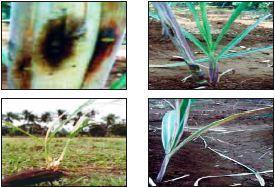 Egg: Flat – scale like eggs are laid in 3-5 rows on the lower surface of leaves in masses of 4-100. The masses are slightly overlapping like tiles. It hatches 4-6days.
Egg: Flat – scale like eggs are laid in 3-5 rows on the lower surface of leaves in masses of 4-100. The masses are slightly overlapping like tiles. It hatches 4-6days. - Larva: Larva is dirty white with five dark violet longitudinal stripes and dark brown head. Duration 16-30days.
- Pupa: Pupation takes within the tunnel. Caterpillar before pupating makes a large exit hole in the stem and blocks the opening with silken discs.
- Adult: Pale greyish brown moth with black dots near the coastal margin of the forewings and with white hind wings.
- Dead heart in 1-3 month old crop, which can be easily pulled out, rotten portion of the straw coloured dead – heart emits an offensive odour. A number of bore holes at the base of the shoot just above the ground level.
Internode borer
Biology Egg: Scale – like oval, flat, shiny and waxy white eggs are laid by female moths in batches of 9-11, near the midribs, on leaf sheaths or on stem.
Egg: Scale – like oval, flat, shiny and waxy white eggs are laid by female moths in batches of 9-11, near the midribs, on leaf sheaths or on stem.- Larva: White larva with four violet longitudinal stripes and light brown head.
- Pupa: Pupation takes place in semi – dried sheath. Pupal period 7 - 10 days
- Adult: Straw coloured with a dark spot on each of the forewings
- Internodes constricted and shortened with a number of bore holes and frass in the nodal region
- Affected tissues reddened
Top shoot borer
Biology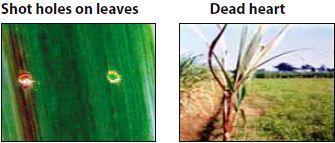 Egg: Eggs are laid on the lower surface of top leaves in clusters particularly near midribs. The clusters are covered with buff coloured hairs. : 10-80 eggs per egg mass
Egg: Eggs are laid on the lower surface of top leaves in clusters particularly near midribs. The clusters are covered with buff coloured hairs. : 10-80 eggs per egg mass- Larva: Smooth, white or cream coloured with a red coloured mid – dorsal line and yellow head.
- Pupa: Pupation takes place within the larval tunnel in a chamber with an exit hole Constructed by the caterpillar. Pupal period 6 - 21 days
- Adult: White Coloured moth (with a buff Coloured anal tuft in the abdominal tip of female)
- Dead heart arises on after sixth month grown up canes, which cannot be easily pulled.
- Parallel row of shot holes in the emerging leaves.
- Bore holes at the top of the shoot and shows bunchy top appearance.
Termites
Biology- Egg: Dull, kidney shaped and hatches in 30-90 days.
- Nymph: Moult 8-9 times and are full grown in 6-12 months.
- Adult: Creamy coloured tiny insects resembling ants with dark coloured head.
 Characteristic semi- circular feeding marks on the leaves in the standing crop
Characteristic semi- circular feeding marks on the leaves in the standing crop- Entire shoot dries up and can be pulled out easily
- Setts hollow inside and may be filled with soil
- Cane collapses if disturbed
- Rind filled with mud.
White grub
Biology- Egg: A female lays on an average of 27 eggs in the soil, which are pear like white enclosed in earthen cells.
- Grub: Fleshy ‘C’ shaped, whitish yellow in colour found close to the base of the clump.
- Pupa: Pupae are tan to brown, and occur deeper in the soil in earthen chambers.
- Adult: Adult beetles are a rusty-red color just after emerging from the pupal stage, but turn nearly black.
- Yellowing and wilting of leaves.
- Drying of entire crown.
- Affected canes come off easily when pulled.
- Cause extensive damage to roots and base of shoot.
EPNs seek out and kill all stages of harmful soil-dwelling insects. They can be used to control a broad range of soil-inhabiting insects and above-ground insects in their soil-inhabiting stage of life. The IJs emerge from cadaver, search for root grubs and termites, infect, kill and again multiply and remain in the moist soil. Root grubs and termites which are major pests in sugarcane can be managed by using EPNs effectively. EPN can be produced even at farmer level using either Galleria or Corcyra as a host.
White woolly aphid
Biology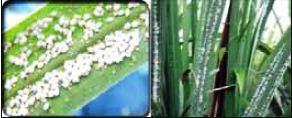 Egg: Eggs are spherical yellow in colour and microscopic.
Egg: Eggs are spherical yellow in colour and microscopic.- Nymph: Nymph takes 6 to 22 days to complete four instars and become adult.
- Adult: Adult emerged after fourth Moult and viviparous reproduction. Apterous (Wingless) female reproduce parthenogenetically. Each female produced about 15 – 35 young ones within 24 hrs. After mating. Each female reproduces maximum of 217 nymphs during the period of 20 days. The life cycle of female complete within one– month period. The longevity of adult is from 32 to 57 days. The life cycle may vary according to the climatic conditions and variety. In most of the affected fields at various locations all the nymphal instars and adults are noticed.
- Adults and nymphs suck sap from leaves by piercing styles through stomata. Whitish patches – coalesce and turn yellowish then drying starts from the tip along margins.
- Leaves become brittle and dry completely. Heavy secretion of honey dew leads to– development of sooty mould, Deposition of woolly matter on ground / soil distinctly visible.
Whitefly
Biology- Egg: Females lay eggs in a line near the midrib or anywhere on the lower surface of the leaves. Eggs are yellowish with a small curved stalk. Colour changes to black about two hours after the eggs are laid.
- Nymph & Pupa: Neonate nymphs are pale yellow in colour, flat and oval in shape, later turn shiny black. Its body is surrounded by fringes of wax. The fourth instar being the pupal stage is flat, oval, grayish in colour and slightly bigger than the nymph. There is a ‘T’ shaped white marking on the thorax, which splits at the time of adult emergence.
- Adult: Pale yellow body with hyaline wings dusted with waxy bloom, exhibit brisk fluttering movements.
- Yellowing of leaves
- Leaf turns pinkish or purple and later gradually dry.
- Infested leaves look white with black dots.
Mealybug
Biology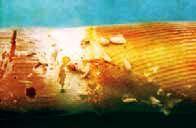 Egg: Eggs are retained in the female reproductive organs until almost fully mature. Incubation period is short. The females may bring forth hundreds of young ones parthenogenetically. Egg is yellowish, smooth, cylindrical and rounded at both ends.
Egg: Eggs are retained in the female reproductive organs until almost fully mature. Incubation period is short. The females may bring forth hundreds of young ones parthenogenetically. Egg is yellowish, smooth, cylindrical and rounded at both ends.- Nymph: Newly emerged nymphs are quite active with a pinkish transparent body.
- Adult: White with mealy coating, sessile.
- Pinkish oval insects beneath leaf sheath on the nodes, with whitish mealy coating, main cane stunned also attack roots. Sooty mould develops on the honey dew giving blackish appearance on canes.
Scale insect
Biology- Nymph: Females multiply ovo-viviparously. The nymphs that hatch out from the eggs within the female’s body come out through the genital aperture. They are called ‘crawlers’. They settle after selecting suitable site for feeding.
- Adult: Greyish black or brown circular scales, they cover the nodal region forming a thick encrustation.
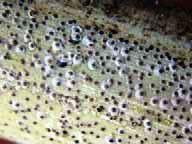 The leaves of infested canes show signs of tip drying and unhealthy pale green colour and with continued infestation these turn yellow.
The leaves of infested canes show signs of tip drying and unhealthy pale green colour and with continued infestation these turn yellow.- Desapping leads to non-opening of leaves also, which also turn yellow and finally dry up.
- Nodal region is more infested than intermodal region.
- Infested crop losses its vigour, canes shrivel, growth is stunted and the Inter nodal length is reduced drastically.
- Ultimately cane dries up. Such canes when slit open appear brownish red.
Nematode
There are several nematodes present in the soil of which, four nematodes are mainly damaging the sugarcane crop. They are:
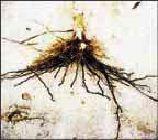 Lesion nematode –Pratylenchus coffeae: Root-lesion nematodes are migratory endo parasites Females of P. penetrans lay about 1 or 2 eggs /day for about 35 days, with a maximum of 68 eggs being laid by one female. Eggs are laid singly or in clusters in both soil and roots. Second stage juveniles hatch after eggs have incubated for 9 (300 C) to 25 (150 C) days. Males are required for reproduction by P. penetrans but not by P. neglectus.
Lesion nematode –Pratylenchus coffeae: Root-lesion nematodes are migratory endo parasites Females of P. penetrans lay about 1 or 2 eggs /day for about 35 days, with a maximum of 68 eggs being laid by one female. Eggs are laid singly or in clusters in both soil and roots. Second stage juveniles hatch after eggs have incubated for 9 (300 C) to 25 (150 C) days. Males are required for reproduction by P. penetrans but not by P. neglectus.- Lance nematode –Hoplolaimus indicus Lance nematodes, Hoplolaimus spp., are ecto-parasites, sometimes semi-endo-parasites. Nematodes which are large are highly resistant to effects of temperature extremes and dry soil conditions. Larvae look similar to adults except that they aresmaller.This group of nematodes is easily detected with soil sampling.
- Root knot nematode –Meloidogyne spp. Root knot nematodes are microscopic roundworms, obligate endo parasites that complete most of their life cycle within their host roots. The nematodes survive in soil as eggs and also second stage larvae.
- Reniform nematode –Rotylenchulus reniformis. The term ‘reniform’ refers to the kidney-shaped body of the mature female. They are semi-endoparasitic (partially inside roots) species in which the females penetrate the root cortex, establish a permanent-feeding site in the stele region of the root and become sedentary or immobile.
- Usually yellowing of leaves, first in the form of streaks, later complete yellowing-chlorosis, occurring in patches spread out all over the field. Chlorosis in severe cases, accompanied by drying up of margins and leaf tips is more common in ratoon and young crop.
- Stunting of crop, reduction in number and size of internodes.
- Roots are stubby and spares.
- Affected field shows pale green to whitish look.
IPM for Sugarcane
To know the IPM practices for Sugarcane, click here.
Source: NIPHM and Directorate of Plant Protection, Quarantine & Storage
Last Modified : 2/13/2020
This topic covers the information related to Pest ...
This topic covers the information related to Pest ...
Provides information about principles to design In...
This topic covers information about Horsegram Ins...
